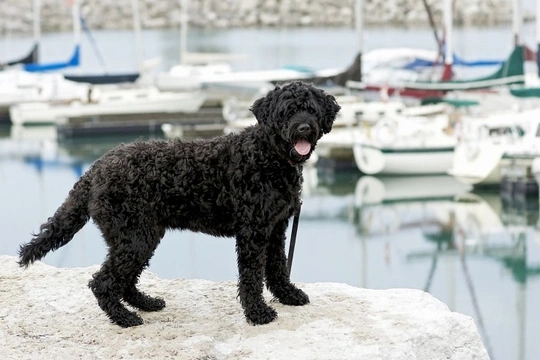
What makes the Portuguese water dog such a good swimmer?
The Portuguese water dog is one of the canine world’s best swimmers – after all, the clue is in the name! This is a distinctive-looking breed that can often be seen sporting a half on, half off haircut called a lion cut, and today, they are very popular as pets in their native Portugal and in many other parts of the world, although they are still not hugely common within the UK.
The breed’s origins, and the origin of their name too, is of course Portugal, where the breed has a long-recorded history of being a working dog breed assisting sea fishermen to carry out their work. Highly versatile, very bold and perfectly at home in the water, the Portuguese water dog has worked in and around the sea for many centuries, performing a number of useful tasks.
Because the breed swims very efficiently and is very bold, they would be used to enter the water and catch and retrieve fishing nets for return to their boat, as well as in some cases swimming to “herd” shoals of fish towards catch nets. There are also recorded incidents of Portuguese water dogs rescuing fishermen from the sea when they fall in, or get into difficulties.
For owners who keep dogs of the breed as pets too, swimming is usually a common part of life for the breed, and even domestic dogs of the breed that have never been used for water-working roles demonstrate a strong affinity for water, and love to swim.
This keenness and high level of swimming confidence is perhaps the breed’s core trait – but it is the dog’s anatomy and temperament that enables them to be such good swimmers, and in combination, the breed’s conformation and attitude is what makes them so keen to get their paws wet.
If you have ever wondered what makes the Portuguese water dog such a good swimmer, wonder no more – in this article, we will look at the core traits that makes the breed so good in the water, and explain why they can swim so well. Read on to learn more.
Webbed feet
First of all, the Portuguese water dog is one of a small handful of dog breeds that have evolved with webbed feet – feet with a thin membrane of skin between the toes that work like flippers to provide a greater surface area within the water, enabling superior propulsion and control as well as buoyancy. This webbing helps the dog to swim more powerfully, and also helps them to walk on sand, uneven ground and mud or other soft surfaces, as the webbing distributes the dog’s weight evenly and helps to stop them from sinking into soft ground.
A balanced conformation
The Portuguese water dog has a well-balanced conformation that is in proportion and not exaggerated, which helps to provide the balance and stability required to swim and float effectively.
Breeds that have large or heavy heads, are highly muscular or stocky or that have proportionally short legs don’t make for good swimmers, and their long legs, balanced heads, and lean but proportionate muscle coverage makes the Portuguese water dog an excellent swimmer.
Long, strong tails
Dogs of the breed also have reasonably long, straight tails that are not disproportionately thick and wide, but are still strong and very mobile. This tail acts as a rudder when the dog is in the water, allowing them to turn and change direction with ease, as well as assisting with forward propulsion, and helping the dog to treat water when needed.
Muscular hind quarters
The breed’s hind quarters are strong and muscular without being overdeveloped, which provides the perfect combination of lots of power and strength for propulsion without weighing the dog down. The hind legs of the dog propel them while swimming, whilst movement of the front legs helps to maintain balance and direction, and keep the head up.
The Portuguese water dog coat
The coat of the Portuguese water dog is single layered and very plush, being wavy or curly in texture and appearance. This coat helps to resist water and avoid becoming waterlogged, which allows the dog to retain buoyancy and avoid being weighed down. It also helps the dog to retain heat at their core, and enables them to dry off quickly when back on land, as the coat does not hold and retain water.
The lion clip
Finally, one of the most popular grooming styles for the Portuguese water dog is also designed to further enhance their ability to swim proficiently, and this is called the lion clip.
The lion clip involves clipping off the fur from the dog’s back legs, hindquarters and the rear part of the stomach, leaving the full coat over the trunk, front limbs and head.
Leaving the front half of the coat intact helps to provide warmth and insulation for the dog’s core, to help them to maintain their endurance in the water, whilst reducing their water resistance and so, enabling more efficient swimming while still allowing the dog to remain comfortable.



